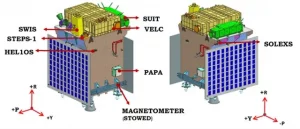Aditya-L1 mission quiz
Aditya-L1 mission quiz

Aditya l1 mission quiz pdf jion teligram channle
quiz chandrayaan 3
what is AI // क्या है ai //type of ai
Reinforcement learning- (RL)-What is RL in reinforcement?-introduction
50 quiz for Aditya mistion
What is the Aditya-L1 mission’s primary objective?
Answer: c) Investigate the Sun and its outermost layer, the corona
Where is the Aditya-L1 spacecraft intended to be positioned for its observations?
Answer: d) At the Lagrangian point L1
What is the Lagrangian point L1 in the context of the Aditya-L1 mission?
Answer: b) A point in deep space where gravitational forces balance
When was the Aditya-L1 mission launched or planned to be launched? (Please verify the latest launch date)
Answer: (The launch date may vary, please verify with the latest information)
Name one of the key instruments onboard the Aditya-L1 spacecraft for solar observations.
Aditya-L1 mission quiz
Answer: (Various instruments are onboard; one example is the Visible Emission Line Coronagraph or VELC)
What are some of the major phenomena and features of the Sun that the Aditya-L1 mission aims to study?
Answer: (Various features and phenomena, including the solar corona, solar wind, solar flares, and magnetic fields)
Which Indian space agency is responsible for the Aditya-L1 mission?
Answer: d) ISRO (Indian Space Research Organisation)
Aditya-L1 mission quiz
How does the Aditya-L1 mission contribute to our understanding of space weather?
Answer: (It provides data and observations to help predict and understand space weather)
What are the potential applications of the data and research obtained from the Aditya-L1 mission?
Answer: (Answers may vary, but potential applications include space weather forecasting, improving satellite communications, and advancing solar energy technologies)
In which part of the electromagnetic spectrum does the Aditya-L1 mission primarily observe the Sun?
Answer: (Primarily in the ultraviolet and visible parts of the spectrum)
Aditya-L1 mission quiz
What is the significance of studying the Sun’s corona in the context of space weather?
Answer: The Sun’s corona is responsible for solar flares and coronal mass ejections (CMEs), which can impact space weather and affect Earth’s magnetic field, satellites, and communication systems.
How does the Aditya-L1 mission plan to protect its instruments and spacecraft from the intense heat and radiation of the Sun?
Answer: The spacecraft is equipped with specialized heat shields and radiation-resistant materials to protect its instruments from the Sun’s extreme conditions.
What is the expected duration of the Aditya-L1 mission’s operations in space?
Answer: The expected mission duration may vary, but it is typically designed to operate for several years.
What are some of the challenges and risks associated with conducting a mission to study the Sun up close?
Answer: Challenges include extreme heat and radiation, precise positioning at the Lagrangian point, and potential spacecraft malfunctions due to solar activity.
How does the Aditya-L1 mission contribute to global efforts to understand and predict solar activity?
Answer: The mission provides valuable data that contributes to global efforts in space weather prediction and understanding the Sun’s influence on Earth.
What is the difference between a solar flare and a coronal mass ejection (CME)?
Answer: A solar flare is a sudden burst of energy and light from the Sun’s surface, while a CME is a massive release of solar material and magnetic fields into space.
How does solar activity, such as solar flares and CMEs, affect Earth’s technological systems and communication networks?
Answer: Solar activity can disrupt satellite communications, power grids, and navigation systems, leading to potential disruptions and outages.
Aditya-L1 mission quiz
What role does the Sun’s magnetic field play in driving solar activity, and how does the Aditya-L1 mission study these magnetic fields?
Answer: The Sun’s magnetic fields play a crucial role in solar activity. Aditya-L1 uses instruments to study magnetic fields and their variations.
Name one international collaboration or partnership associated with the Aditya-L1 mission.
Answer: (This may vary, but international collaborations are common in space missions for data sharing and research.)
How can the knowledge gained from the Aditya-L1 mission benefit space exploration and future human missions to other celestial bodies?
Answer: Knowledge of space weather and solar activity is critical for protecting astronauts and spacecraft during space exploration.
Aditya-L1 mission quiz
What are the key scientific objectives of the Aditya-L1 mission, aside from studying the Sun’s corona?
Answer: Scientific objectives may include studying solar magnetic fields, solar wind, and the Sun’s influence on Earth’s magnetosphere.
Explain the concept of space weather and why it is important to monitor it.
Answer: Space weather refers to the conditions in space influenced by the Sun’s activity. Monitoring it is crucial for protecting technology and infrastructure on Earth and in space.
What are some of the challenges faced by scientists and engineers in designing and executing the Aditya-L1 mission?
Answer: Challenges include building instruments to withstand extreme conditions, precise orbital positioning, and data transmission from a distant location.
Describe the trajectory or path that the Aditya-L1 spacecraft follows to reach its designated position for solar observations.
Aditya-L1 mission quiz
Answer: The spacecraft follows a trajectory to reach the Lagrangian point L1, where it remains in a stable position between the Earth and the Sun.
How does the Aditya-L1 mission contribute to our understanding of the Sun’s impact on Earth’s climate?
Answer: The mission may study the Sun’s influence on the Earth’s climate by observing solar variability and its potential effects on climate patterns.
What is the expected lifespan of the Aditya-L1 spacecraft in its mission orbit?
Answer: The expected lifespan may vary but is typically designed to operate for several years.
Name one previous mission or satellite that has contributed significantly to our knowledge of the Sun and solar activity.
Answer: One example is the Solar and Heliospheric Observatory (SOHO).
What are some of the safety measures taken during the launch and positioning of the Aditya-L1 spacecraft at the Lagrangian point L1?
Answer: Safety measures include precise calculations for positioning, redundancy in systems, and contingency plans for spacecraft emergencies.
What is the role of the Aditya-L1 mission in studying the Sun’s magnetic fields and their variations?
Aditya-L1 mission quiz
Answer: The mission uses specialized instruments to study the Sun’s magnetic fields, helping scientists understand their behavior and impact on space weather.
How does the Aditya-L1 mission help improve space weather forecasts and predictions?
Answer: The mission provides real-time data that helps improve models and forecasts of space weather events.
Describe the instruments onboard the Aditya-L1 spacecraft and their specific functions in solar observation.
Answer: (Specific instruments may vary, but examples include spectrometers, imagers, and magnetometers, each with unique functions in studying the Sun.)
What is the significance of studying the Sun’s poles in the Aditya-L1 mission?
Answer: Studying the Sun’s poles helps researchers understand its magnetic field and its influence on solar activity.
Aditya-L1 mission quiz
How does the Aditya-L1 mission monitor solar flares and their potential impact on Earth?
Answer: The mission’s instruments can detect and observe solar flares, providing data for space weather forecasts.
Explain the concept of “solar wind” and how it is studied by the Aditya-L1 mission.
Answer: Solar wind is a stream of charged particles from the Sun. The mission studies solar wind to understand its composition and variations.
How does the Aditya-L1 mission contribute to the development of solar energy technologies?
Answer: Research on the Sun’s behavior can inform advancements in solar energy technologies.
What are the potential risks to the Aditya-L1 spacecraft due to its proximity to the Sun?
Answer: Risks include extreme heat, radiation, and potential damage from solar flares and CMEs.
What is the role of data analysis and modeling in interpreting the observations made by the Aditya-L1 mission?
Aditya-L1 mission quiz
Answer: Data analysis and modeling help scientists make sense of the vast amount of data collected and understand solar phenomena.
How does the Aditya-L1 mission coordinate with other space agencies and observatories worldwide to enhance solar research?
Answer: Collaboration involves sharing data, resources, and research findings to improve our understanding of the Sun.
Explain the concept of the “solar minimum” and “solar maximum” phases of the Sun’s activity cycle.
Aditya-L1 mission quiz
Answer: Solar minimum is a period of reduced solar activity, while solar maximum is a period of increased solar activity, marked by more solar flares and CMEs.
How does the Aditya-L1 mission help protect Earth’s satellites and communication systems from the effects of solar storms?
Answer: By providing real-time data on solar activity, the mission helps operators of satellites and systems prepare for and mitigate the effects of solar storms.
What are some of the technological advancements made possible by the Aditya-L1 mission?
Answer: Advancements may include improved spacecraft technology, better instruments for solar observation, and enhanced space
Aditya-L1 mission quiz
weather prediction tools.
Describe the collaboration between scientists, engineers, and mission planners in the development of the Aditya-L1 spacecraft.
Answer: Collaboration involves designing instruments, planning the mission trajectory, and ensuring the spacecraft’s success.
Aditya-L1 mission quiz
How does the Aditya-L1 mission contribute to our understanding of the Sun’s influence on Earth’s climate and weather patterns?
Answer: By studying solar variability, the mission provides data that can help researchers explore potential links between solar activity and climate.
What are the key differences between the Aditya-L1 mission and other solar observation missions, such as the Parker Solar Probe?
Answer: Differences may include mission objectives, orbits, and instrument capabilities. The Parker Solar Probe, for example, gets closer to the Sun.
What role does the Aditya-L1 mission play in educating and inspiring future generations of scientists and engineers?
Answer: The mission can serve as an educational tool and source of inspiration for students interested in space science and technology.
Aditya-L1 mission quiz
How does the Aditya-L1 mission mitigate the challenges of space radiation and extreme temperatures during its mission?
Answer: The spacecraft is designed with radiation shielding and thermal control systems to protect instruments and systems.
What are the potential commercial applications or benefits of the data and technology developed for the Aditya-L1 mission?
Answer: Commercial applications may include improved space weather forecasting for satellite operators and telecommunications companies.
Describe the process of launching and positioning the Aditya-L1 spacecraft at the Lagrangian point L1.
Answer: The spacecraft is launched into a transfer orbit and then maneuvers to reach L1, where it uses small propulsion systems to maintain its position.
Aditya-L1 mission quiz
How does the Aditya-L1 mission contribute to international efforts to better understand space weather and its impacts on Earth?
Answer: Collaboration and data sharing with international partners enhance our collective understanding of space weather.
What is the expected timeline for the release of significant findings and discoveries from the Aditya-L1 mission?


